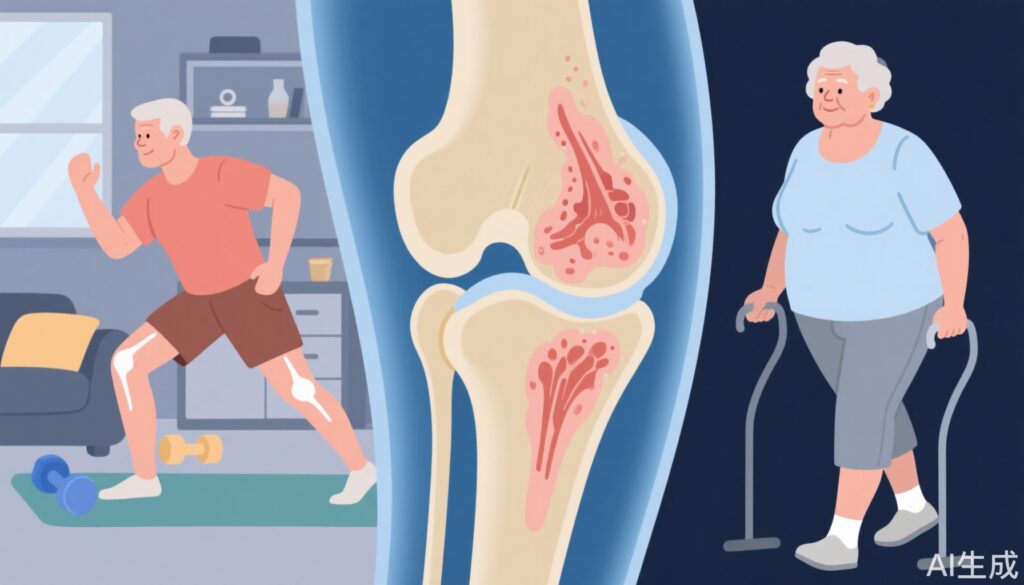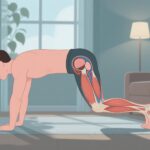Highlights
- In overweight or obese adults with hip osteoarthritis, a very-low-calorie diet combined with exercise did not provide greater pain relief than exercise alone.
- Both interventions led to clinically significant reductions in hip pain at 6 months.
- The diet-plus-exercise group achieved more weight loss and modestly better quality-of-life outcomes but not superior pain reduction.
- No serious adverse events were associated with either intervention.
Study Background and Disease Burden
Osteoarthritis (OA) of the hip is a prevalent chronic joint condition, leading to pain, functional impairment, and reduced quality of life, particularly in adults aged 50 years and older. Overweight and obesity are widely recognized risk factors for the development and progression of hip OA, raising the question of whether intentional weight loss confers clinical benefit in this population. While weight loss is strongly recommended in knee OA, the evidence for its role in hip OA has been less robust and sometimes contradictory. There remains an unmet need for high-quality data to guide optimal non-surgical management strategies for hip OA in overweight or obese individuals.
Study Design
This Australian multicenter, two-group superiority randomized controlled trial (ClinicalTrials.gov: NCT04825483) addressed this gap by enrolling 101 adults (BMI >27 kg/m²) with radiographically confirmed hip osteoarthritis and chronic hip pain (≥3 months duration). Participants were randomized to one of two arms for 6 months:
- Exercise Alone: Home-based exercise program with five telehealth physiotherapy consultations.
- Very-Low-Calorie Diet (VLCD) Plus Exercise: The same exercise program, plus a ketogenic VLCD delivered via six telehealth dietitian consultations.
The primary endpoint was the change in hip pain severity at 6 months, measured on an 11-point numeric rating scale (0=no pain, 10=worst pain), with a minimum clinically important difference (MCID) of 1.8 points. Secondary outcomes included other pain metrics, Hip Disability and Osteoarthritis Outcome Score (HOOS) domains, physical function, quality of life, body weight, composition, and adverse events. Follow-up continued to 12 months post-randomization.
Key Findings
At 6 months, both groups experienced clinically meaningful reductions in hip pain severity: the exercise-only group improved by 2.0 points, and the VLCD plus exercise group by 2.8 points. However, the between-group difference in pain reduction was not statistically significant (mean difference, -0.6 points; 95% CI, -1.5 to 0.3), failing to meet the MCID and indicating no superiority of VLCD plus exercise over exercise alone for pain relief.
The VLCD plus exercise group achieved significantly greater weight loss, averaging 8.5% more than the exercise-only group. At 12 months, sustained improvements in body weight, BMI, and hip function (HOOS pain and function subscales) favored the VLCD plus exercise group. Notably, a larger proportion of the diet-plus-exercise group reached the threshold for a clinically relevant reduction in pain (≥1.8 points) at 6 months compared to exercise alone.
Quality of life outcomes showed a modest but consistent advantage for the VLCD plus exercise group at both 6 and 12 months. However, no significant between-group differences were observed in overall physical activity levels. Importantly, no serious adverse events related to the interventions were reported, supporting the safety of both approaches in this population.
A summary table is provided below:
| Outcome | Exercise Alone | VLCD + Exercise | Between-Group Difference |
|---|---|---|---|
| 6-mo Hip Pain Reduction (0-10 scale) | -2.0 | -2.8 | -0.6 (95% CI, -1.5 to 0.3) |
| Weight Loss (%) | – | 8.5% more | Significant |
| HOOS Pain/Function (12 mo) | – | Favored VLCD+Ex | Significant |
| Quality of Life (12 mo) | Improved | Slightly greater improvement | Not statistically significant |
| Serious Adverse Events | 0 | 0 | None |
Expert Commentary
Kim Bennell, PhD, physiotherapist and study co-author at the University of Melbourne, noted that while weight loss is a cornerstone of non-operative management for knee OA, evidence for the same approach in hip OA has lagged. This trial is one of the few rigorously designed studies to directly address the question. The results challenge the prevailing assumption that weight loss is essential for symptomatic relief of hip OA in overweight or obese adults, suggesting that a structured exercise program alone provides substantial benefit.
The observed improvements in pain and function with exercise alone reflect the established efficacy of physical activity interventions in OA, possibly via mechanisms including muscle strengthening, improved joint mechanics, and modulation of pain signaling. While the addition of a VLCD led to superior weight loss and slight quality-of-life gains, the lack of corresponding additional pain relief may indicate distinct pathophysiologic differences between hip and knee OA, or that biomechanical load reduction is less consequential for the hip joint.
Limitations of the study include the relatively short duration (6-12 months), the use of telehealth (which may limit generalizability), and exclusion of individuals with severe comorbidities or advanced OA. Longer-term data will be important to assess whether weight loss influences OA progression or need for joint replacement surgery.
Conclusion
For overweight or obese adults with hip osteoarthritis, a very-low-calorie weight loss diet combined with exercise does not provide greater pain reduction than exercise alone, although it results in more weight loss and modest quality-of-life improvement. Exercise remains the primary non-surgical intervention for hip OA pain, while the role of weight loss may be more nuanced than previously thought. Ongoing research should continue to clarify the indications for weight management in this population, particularly with regard to long-term structural outcomes.
References
1. Hall M, Hinman RS, Knox G, Spiers L, McManus F, De Silva AP, Sumithran P, Harris A, Murphy NJ, Cicuttini F, Hunter DJ, Messier SP, Bennell KL. Efficacy of a Very-Low-Calorie Weight Loss Diet Plus Exercise Compared With Exercise Alone on Hip Osteoarthritis Pain: A Randomized Controlled Trial. Ann Intern Med. 2025 Aug 5. doi: 10.7326/ANNALS-25-00045. Epub ahead of print. PMID: 40759020.
2. Hunter DJ, Bierma-Zeinstra S. Osteoarthritis. Lancet. 2019 Apr 27;393(10182):1745-1759. doi:10.1016/S0140-6736(19)30417-9.
3. Bennell KL, et al. Physical therapies in the management of osteoarthritis. Best Pract Res Clin Rheumatol. 2014 Feb;28(1):93-117. doi:10.1016/j.berh.2014.01.002.



